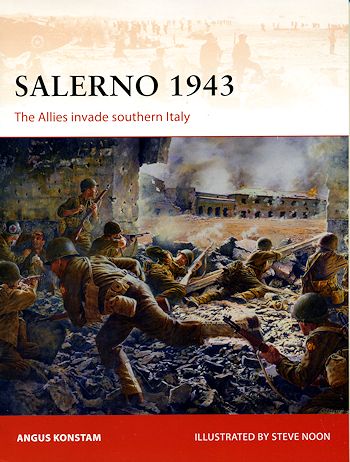Osprey's Salerno 1943
|
Author: |
Angus Konstam, illustrated by Mark Stille |
|
Publisher/Distributor |
Osprey Publishing |
|
Price |
$21.95 MSRP |
|
Reviewer: |
Scott Van Aken
|
|
Notes: |
96 pages, 7¼ x 9¼ inches, softcover
ISBN:978-1-78096-249-8 |
 Once
Sicily had been occupied by that Allies, it was pretty obvious that mainland
Italy would have to be next. The big question was where. There were several
choices from very southern Italy, to the Adriatic coast and a number of places
up the western side. It was quickly obvious that the Adriatic coast would not be
good due to the issues with air cover. Basically the Allies would have little or
none, the Luftwaffe would have bases relatively close by and ships would have to
maneuver in the relatively narrow confines of the Adriatic.
Once
Sicily had been occupied by that Allies, it was pretty obvious that mainland
Italy would have to be next. The big question was where. There were several
choices from very southern Italy, to the Adriatic coast and a number of places
up the western side. It was quickly obvious that the Adriatic coast would not be
good due to the issues with air cover. Basically the Allies would have little or
none, the Luftwaffe would have bases relatively close by and ships would have to
maneuver in the relatively narrow confines of the Adriatic.
The heel of Italy wasn't the first choice
either as troops would have to fight up the entire length of Italy. So it had to
be the western sides. The place chosen had to be within the range of Allied air
power without having to use aircraft carriers, it also had to be open enough to
handle the mass of ships and the landing beaches had to be relatively broad.
An area around the town of Salerno, just
south of Naples was chosen. It was at the near limit of Allied air power and
provided many of the pluses sought by the Allies in terms of a broad, open bay
and open beaches. A down side of it was that it was surrounded by hills from
which enemy artillery would be able to easily see the troops on the beaches.
However, no landing is without risk and so it was decided.
The Americans would land in the northern
section and the British in the southern section. Salerno Bay was fed by many
small rivers, more like streams, that came down from the mountains. Small they
were, but they were enough of an obstacle that they could not be easily crossed
unless by bridges. They also tended to confine units within the boundaries of a
pair of these small rivers, channeling the attacking troops.
The Allies also hoped that by invading
shortly after the Armistice with Italy would not allow the Germans to be
properly situated. In this, they were wrong and the Germans were in full control
of defensive positions by the time of the landings. Where the Allies lucked out
is that there were not any beach obstacles such as they ran into at Normandy.
This unexpected strength in German forces
was a major surprise to the Allies and were it not for the assistance of naval
gunfire from ships off shore, it is quite probable that the landings would have
failed. Though a bloody battle where the Allies suffered many times the
casualties of the defending Germans, the Allies were able to gain a hold and
move north towards Naples.
There is, of course, much more to the
tale than the outline provided above.
Author Angus Konstam does a masterful job of telling the tale of hopes,
incompetence, bravery and eventual Allied success. Though greatly outnumbered,
the Germans did quite well in slowing down and nearly defeating the landing. This is all enhanced by some great period
photos from both sides and the art work of Mark Stille. As is typical of the
series, we are provided with some great campaign maps and information on
visiting this area today. Overall, it is a fascinating read of this important
operation and one that I can easily recommend to you.
July 2013
For more on the complete line of Osprey books,
visit www.ospreypublishing.com. In the US, it is
Osprey Direct at 44-02 23rd St, Suite 219, Long Island City, NY 11101., where you can
get a catalogue of available books.
If you would like your product reviewed fairly and fairly quickly, please
contact
the editor or see other details in the
Note to
Contributors.
 Once
Sicily had been occupied by that Allies, it was pretty obvious that mainland
Italy would have to be next. The big question was where. There were several
choices from very southern Italy, to the Adriatic coast and a number of places
up the western side. It was quickly obvious that the Adriatic coast would not be
good due to the issues with air cover. Basically the Allies would have little or
none, the Luftwaffe would have bases relatively close by and ships would have to
maneuver in the relatively narrow confines of the Adriatic.
Once
Sicily had been occupied by that Allies, it was pretty obvious that mainland
Italy would have to be next. The big question was where. There were several
choices from very southern Italy, to the Adriatic coast and a number of places
up the western side. It was quickly obvious that the Adriatic coast would not be
good due to the issues with air cover. Basically the Allies would have little or
none, the Luftwaffe would have bases relatively close by and ships would have to
maneuver in the relatively narrow confines of the Adriatic.